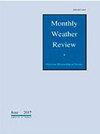寒潮对南海边界层结构、能量收支和湍流的影响
IF 2.8
3区 地球科学
Q3 METEOROLOGY & ATMOSPHERIC SCIENCES
引用次数: 0
摘要
东亚冬季季风中的偶发性寒潮会深入中国南海(SCS),增强随之而来的热带降雨,并进一步加强东亚经向翻转环流。这些冷涌可促进强大的表层通量,并导致海洋边界层(MBL)加深。然而,与北大西洋和中东太平洋等许多其他研究较多的区域不同,目前缺乏对 SCS 边界层的研究。在本研究中,我们利用东沙岛(东经 116.69 度,北纬 20.70 度)上空的高分辨率无线电探空仪温度和湿度剖面数据,识别了 2010 年 12 月至 2020 年 1 月至 2 月期间的反转层、混合层、云基、云顶以及控制低云量的因素。我们利用ERA-5气象变量和表面通量进行了能量预算分析。结果表明,在寒潮期间,SCS MBL 内的热量和水汽都有很强的湍流汇聚,导致混合层抬升到 ~1.0 km,反转层抬升到 ~2.0 km,东沙岛上空的云也随之发展。在能量收支中,干冷的水平平流与这种垂直湍流收敛相平衡。总体而言,南中国海上空的冷涌增强了冬季季风经向翻转环流的下分支,使其具有更强的反转和更高的低云层。本文章由计算机程序翻译,如有差异,请以英文原文为准。
Cold Surge Impacts on the Structure, Energy Budget, and Turbulence of the South China Sea Boundary Layer
Episodic cold surges in the East Asia winter monsoon can penetrate deep into the South China Sea (SCS), enhance consequent tropical rainfall, and further strengthen the East Asia meridional overturning circulation. These cold surges can promote strong surface fluxes and lead to a deeper marine boundary layer (MBL). However, there is a lack of boundary layer studies over the SCS, unlike many other well-studied regions such as the north Atlantic Ocean and the central-eastern Pacific Ocean. In this study, we use high resolution radiosonde data of temperature and humidity profiles over Dongsha Island (116.69E, 20.70N) to identify the inversion layer, mixed layer, cloud base, cloud top, and factors controlling low cloud cover for the period of December-January-February from 2010 to 2020. We perform an energy budget analysis with ERA-5 meteorological variables and surface fluxes. Here we show a strong turbulent flux convergence of both heat and moisture within the SCS MBL during cold surges, which leads to a lifting of the mixed layer to ~1.0 km and inversion layer to ~2.0 km and associated cloud development over Dongsha Island. The cold and dry horizontal advection is balanced by this vertical turbulent flux convergence in the energy budget. Overall, cold surges over the SCS enhance lower branch of winter monsoon meridional overturning circulation with stronger inversion and higher low cloud covers.
求助全文
通过发布文献求助,成功后即可免费获取论文全文。
去求助
来源期刊

Monthly Weather Review
地学-气象与大气科学
CiteScore
6.40
自引率
12.50%
发文量
186
审稿时长
3-6 weeks
期刊介绍:
Monthly Weather Review (MWR) (ISSN: 0027-0644; eISSN: 1520-0493) publishes research relevant to the analysis and prediction of observed atmospheric circulations and physics, including technique development, data assimilation, model validation, and relevant case studies. This research includes numerical and data assimilation techniques that apply to the atmosphere and/or ocean environments. MWR also addresses phenomena having seasonal and subseasonal time scales.
 求助内容:
求助内容: 应助结果提醒方式:
应助结果提醒方式:


